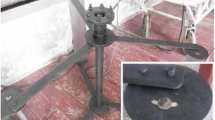Abstract
In the past decade, the tidal energies have caused worldwide concern as it can provide regular and predictable renewable energy resource for power generation. The majority of technologies for exploiting the tidal stream energy are based on the concept of the horizontal axis propellers, which can be derived from the design and operation of wind turbines. However, there are some peculiar features such as the propeller working in the seawater with free surface and the possible occurrence of cavitation as compared with wind turbines. Especially, for a counter-rotating type tidal stream power turbine, it is difficult to accurately predict the interaction between the front and rear blades at the design stage by blade element momentum theory. As a result, CFD shows its advantage to predict the performance of counter-rotating type propellers of the tidal stream turbine. In order to improve the accuracy of CFD predictions, the predicted results must be verified with experimental values. In this paper, a CFD model using block-structured grid was set up and experimental test was performed in a water tunnel for a tidal stream turbine with counter-rotating type propellers. The comparison between CFD predictions and experimental data shows quite good agreement on the power coefficients, which provides an evidence of validation of the CFD model. Such results offer the necessary confidence in the accuracy of the set up CFD model for the counter-rotating type tidal stream turbine.
Similar content being viewed by others
References
Greenwood, C., Hohler, A., Hunt, G.: Global Trends in Sustainable Energy Investment 2007. Analysis of Trends and Issues in the Financing of Renewable Energy and Energy Efficiency in OECD and Developing Countries. http://www.unep.org/. United Nations Environment Programme, (2007).
Fang, L.F.: The Myth of China's Endless Coal Demand. http://www.greenpeace.org/usa/en/media-center/reports/Myth-of-China-Endless-Coal-Demand/. Greenpeace USA, (2013).
Ellabban, O., Abu-Rub, H., Blaabjerg, F.: Renewable energy resources: Current status, future prospects and their enabling technology, Renewable and Sustainable Energy Reviews, Vol. 39, pp.748–764, (2014).
World Energy Council, 2010 Survey of Energy Resources. http://www.worldenergy.org/wp-content/uploads/2012/09 /ser_2010_report_1.pdf. (Nov., 2010.
Bedard, R., Jacobson, P.T., Previsic, M., Musial, W., and Varley, R.: An overview of ocean renewable energy technologies, Oceanography, Vol. 23, No. 2, pp.22–31, (2010).
http://en.wikipedia.org/wiki/Tidal_stream_generator.
Fraenkel, P.: Power from marine currents, Proc IMechE Part A: J. Power and Energy, Vol. 216, No. 1, pp.1–14, (2012).
Ben Elghali, S.E., Benbouzid, M., Charpentier, J.F.: Marine tidal current electric power generation technology: state of the art and current status, IEEE International electric machines & drives conference, Antalya, Turkey, pp. 1407–1412, (2007).
Batten, W.M.J., Bahaj, A.S., Molland, A.F., Chaplin, J.R.: Hydrodynamics of marine current turbines, Renewable Energy, Vol. 31, No. 2, pp.249–256, (2006).
Burton, T., Sharpe, D., Jenkins, N., Bossanyi, E.: Wind energy handbook, Chichester: Wiley, (2000).
Batten, W.M.J., Bahaj, A.S., Molland, A.F., Chaplin, J.R.: Experimentally validated numerical method for the hydrodynamic design of horizontal axis tidal turbines, Ocean Engineering, Vol. 34, No.7, pp.1013–1020, (2007).
Bahaj, A.S., Molland, A.F., Chaplin, J.R., Batten, W.M.J.: Power and thrust measurements of marine current turbines under various hydrodynamic flow conditions in a cavitation tunnel and a towing tank, Renewable Energy, Vol. 32, No. 3, pp.407–426, (2007).
Bahaj, A.S., Batten, W.M.J., McCannb, G.: Experimental verifications of numerical predictions for the hydrodynamic performance of horizontal axis marine current turbines, Renewable Energy, Vol. 32, No. p15, pp.2479–2490, (2007).
Batten, W.M.J., Bahaj, A.S., Molland, A.F., Chaplin, J.R.: The prediction of the hydrodynamic performance of marine current turbines, Renewable Energy, Vol. 33, No. 5, pp.1085–1096, (2008).
Usui, Y., Kanemoto, T., Hiraki, K.: Counter-Rotating Type Tidal Stream Power Unit Boarded on Pillar (Performances and Flow Conditions of Tandem Propellers), Journal of Thermal Science, Vol. 22 No. 6, pp.580–585, (2013).
Usui, Y., Takaki, K., Kanemoto, T., Hiraki, K.: Counterrotating type tidal-stream power unit playing favorable features in various ocean circumstances, IMECE2013, San Diego, California, USA, (2013).
Suzuki, T and Kanemoto, T.: Counter-Rotating Type Tidal Range Power Unit, Journal of Energy and Power Engineering, Vol.7, No. 12 (2013, Dec), pp.2381–2387.
Author information
Authors and Affiliations
Rights and permissions
About this article
Cite this article
Huang, B., Kanemoto, T. Performance and internal flow of a counter-rotating type tidal stream turbine. J. Therm. Sci. 24, 410–416 (2015). https://doi.org/10.1007/s11630-015-0803-1
Received:
Published:
Issue Date:
DOI: https://doi.org/10.1007/s11630-015-0803-1



